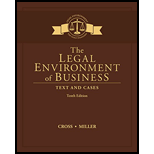
Case summary: Company TGS conducted an aerial geo-physical survey of eastern Canada for more than 15,000 square miles. There was a concentration of commercially exploited minerals which was indicated because of the operation. A hole was drilled by TGS to yield the core with an exceedingly high content of minerals. The result of the survey was not made public. The employees purchased the stock of TGS after knowing about the samples. The price of stock TGS rose, after the survey report was published in the newspaper. SEC filed a case against the organization’s employees for insider trading. The employees claimed that the information on the basis of which they traded is not a material.
To explain: The liability of company, if enough ore was not found after drilling of the area.
Want to see the full answer?
Check out a sample textbook solution
Chapter 28 Solutions
The Legal Environment of Business: Text and Cases (MindTap Course List)
- Elba Industries produces a single product: solar-powered lanterns for outdoor use. The budget going into the current year anticipated a selling price of $72 per unit. Due to market competition, the company had to reduce the selling price by 12% during the year. Budgeted variable costs per unit are $45, and budgeted total fixed costs are $180,000 for the year. The anticipated sales volume for the year was 15,000 units. Actual sales volume was 6% lower than budget. What was the sales price variance for the year?arrow_forwardNo Aiarrow_forwardFinancial accountingarrow_forward
- At year-end, Simple has cash of $12,000, current accounts receivable of $60,000, merchandise inventory of $37,200, and prepaid expenses totaling $5,200. Liabilities of $24,000 must be paid next year. Assume accounts receivable had a beginning balance of $20,000 and net credit sales for the current year totaled $2,400,000. How many days did it take Simple to collect its average level of receivables? (Assume 365 days/year.)arrow_forwardPerry Industries is preparing its direct labor budget for the next two months. Each unit of output requires 0.85 direct labor hours. The direct labor rate is $12 per direct labor hour. The production budget calls for producing 7,200 units in June and 7,000 units in July. The company guarantees its direct labor employees a 40-hour paid work week, and with the current workforce, this means they are committed to paying for at least 5,900 labor hours per month, even if there isn't enough work to occupy all that time. What would be the total combined direct labor cost for the two months?arrow_forwardPlease provide the correct answer to this financial accounting problem using valid calculations.arrow_forward
 Purchasing and Supply Chain ManagementOperations ManagementISBN:9781285869681Author:Robert M. Monczka, Robert B. Handfield, Larry C. Giunipero, James L. PattersonPublisher:Cengage Learning
Purchasing and Supply Chain ManagementOperations ManagementISBN:9781285869681Author:Robert M. Monczka, Robert B. Handfield, Larry C. Giunipero, James L. PattersonPublisher:Cengage Learning
